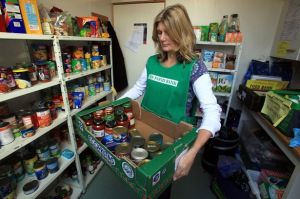>> As organizations try to meet the needs of the thousands of North Carolinians living in poverty, food collection bins at our local stores are almost more common than holiday decorations. Well-meaning shoppers pile in items that will only temporarily fill the pantries of people in need.
As organizations try to meet the needs of the thousands of North Carolinians living in poverty, food collection bins at our local stores are almost more common than holiday decorations. Well-meaning shoppers pile in items that will only temporarily fill the pantries of people in need.
Don’t get me wrong; I’m not against food donations. Food Banks are counting on them — though we should all keep the momentum up throughout the year. But I read something recently that made me think. Research by Lindsey Smith at UNC Chapel Hill found that >>21st century Americans don’t know how to cook, and that this deficiency may be having a disproportionate impact on people in poverty.
Her analysis points out that many schools are phasing out Home Economics education. Plus, as parents are working and have less time to cook, children are missing out on cooking instruction at home. How does that impact people living in need? We can donate all the canned tomatoes and beans that we want, but if people don’t know how what to do with those cans of veggies, our generosity is going to waste.
On top of that, cooking takes time. If you are working multiple jobs to make ends meet, how do you squeeze in the extra time to cook a meal for your family?
Here’s what I propose: we can donate food items that are ready to eat. There are lots of meals now where you can add water and have instant pasta in an individual serving. There are ready to eat soups. I’m not saying they’re as good for you as freshly prepared, whole grain foods — but it’s better than grabbing a handful of cereal or a candy bar.
Many food banks are also trying to meet the need by offering cooking classes. Share Our Strength’s >>Cooking Matters program offers instruction on food preparation and nutrition so people receiving food donations can utilize them in the best way. The program reports increased nutrition and even healthy weight loss by some of its participants. You can also volunteer for that program. >>Check out their website.
As for your own household: I encourage you to cook when you can and teach your children about it. The value of a home cooked meal goes way beyond nutrition. Some of my fondest memories of my childhood are cooking with my mother, and I’m trying to provide the same memories for my daughters. Sure — getting kids involved leaves a little extra flour on the floor and butter on the cabinets, but they love it and it’s a skill set they may only get from home.
There are no comments
Add yours